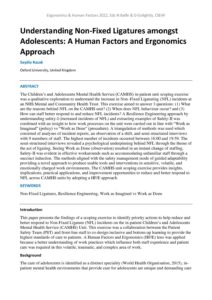| Document | Author Saydia Razak |
| Abstract The Children’s and Adolescents Mental Health Service (CAMHS) in-patient unit scoping exercise was a qualitative exploration to understand the increase in Non–Fixed Ligaturing (NFL) incidents at an NHS Mental and Community Health Trust. This exercise aimed to answer 3 questions: (1) What are the reasons behind NFL on the CAMHS unit? (2) When does NFL behaviour occur? and (3) How can staff better respond to and reduce NFL incidents? A Resilience Engineering approach by understanding safety-I (increased incidents of NFL) and extracting examples of Safety-II was combined with an insight to how work processes on the unit were carried out in line with “Work as Imagined” (policy) vs “Work as Done” (procedure). A triangulation of methods was used which consisted of analyses of incident reports, an observation of a shift, and semi-structured interviews with 9 members of staff. The highest number of incidents occurred between 16:00 and 19:59. The semi-structured interviews revealed a psychological underpinning behind NFL through the theme of the act of ligating. Seeing Work as Done (observation) resulted in an instant change of staffing. Safety-II was evident in effective workarounds such as accommodating unfamiliar staff through a succinct induction. The methods aligned with the safety management mode of guided adaptability providing a novel approach to produce usable tools and interventions in sensitive, volatile, and emotionally charged work environments. The CAMHS unit scoping exercise provides insights, implications, practical applications, and improvement opportunities to reduce and better respond to NFL across CAMHS units by adopting a HF/E approach. |

